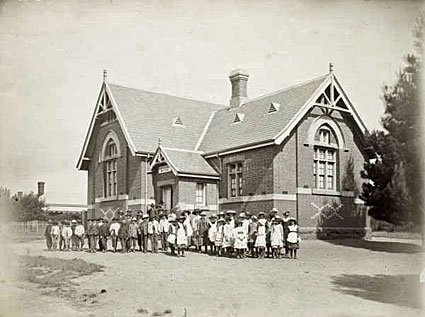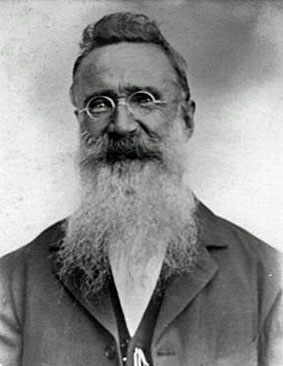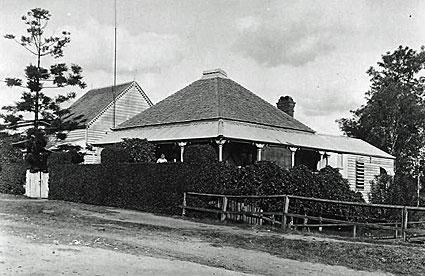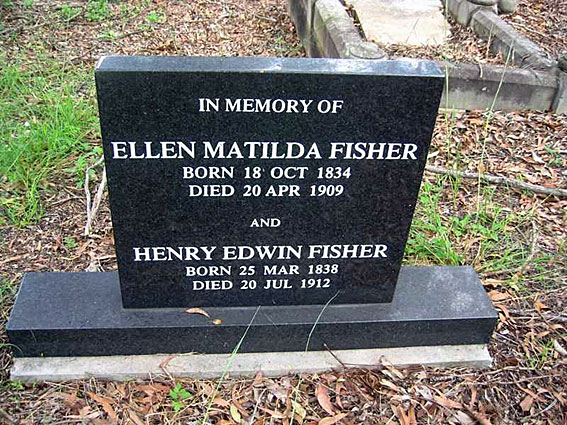
The former Kingston Primary School in 1909,
now a private residence
[Photograph: La Trobe Library, State Library of Victoria]

The former Kingston Primary School in 1909,
now a private residence
[Photograph: La Trobe Library, State Library of Victoria]
Historical and Technical Documentation by Geoffrey Cox
© OHTA 2012 (last updated September 2012)
This organ, built by Henry Edwin Fisher of Brisbane, is one of at least two built in Queensland under the inspiration of Mark Wicks' book, Organ building for Amateurs: A Practical Guide for Home-Workers (London & New York: Ward, Lock, 1887). Both had pipes made of paper or cardboard. The other was built around 1890 by Gerard Gore at the homestead of the Gore family, Yandilla. The present instrument was brought to light after a century of obscurity when Mark Fisher of Pipe Organ Reconstructions Pty Ltd (not related to H.E. Fisher), was invited to restore it in 1997.1

The organ built by H.E. Fisher, restored by Mark Fisher,
and installed at Warrawee, NSW, in 2001
[Photograph by Mark Fisher (June 2001)]
Henry Edwin Fisher (1838-1912) was a carpenter by trade. He had been born in Gloucester, UK, and built the residence in Broadway Street, Woolloongabba, into which he and his wife moved in 1880. It is estimated that he built the organ there between 1895 and 1900.2 H.E. Fisher and his wife, Ellen Matilda Fisher, were listed on the electoral roll at this address as late as 1905 and 1908.3 After the death of his wife, Mr Fisher seems to have moved to live at Latrobe Street, East Brisbane, with Fanny Fisher.4 Henry Edwin Fisher and Ellen Matilda Fisher are buried together in the South Brisbane cemetery, Dutton Park.5

Henry Edwin Fisher (1838-1912)
[Photograph supplied by Graham Fisher (July 2012)]

The former residence of Henry Edwin Fisher
at Broadway Street, Woolloongabba
[Photograph supplied by Graham Fisher (July 2012)]

The headstone for Henry Edwin Fisher and Ellen Matilda Fisher
[South Brisbane Cemetery]
Information supplied by Graham Fisher, the present owner of the organ and a great grandson of H.E. Fisher, suggests that there were problems from the start with the winding of the instrument, rendering it unplayable:
When [H.E. Fisher] finished building the organ he was apparently very disappointed because lack of sufficient airflow meant that it was virtually unplayable. It was dismantled and went to Marrickville in Sydney where his sister Lucy Robinson (née Fisher) lived with her husband Chris. Subsequently it was inherited by her son Henry and upon his death it was purchased from the estate by my cousin Alyson Broadfoot (née Ashe). She commissioned Mark Fisher (no relation) to undertake the restoration of the organ.6
The organ had been moved to Sydney early in the twentieth century,7 probably when H.E. Fisher moved to East Brisbane after the death of his wife. It was at 75 Newington Street, Stanmore, the former residence of Henry Robinson, when it came to light in 1997. Mark Fisher was commissioned by Alyson Broadfoot to restore the instrument, and inspected it at Stanmore at this time. After initial cleaning and re-assembly at the factory, however, Fisher discovered that the organ would still not play properly. There were fundamental design and construction faults in the windchests, producing insurmountable runnings and cyphers. It was not until the first half of 2001 that the necessary remedial work was undertaken. This included the complete dismantling and rebuilding of the windchests.8 Metal pipes were substituted for the paper trebles of the Flageolet, and metal Clarinet pipes replaced the paper and free reeds of the Bassoon Bass. Electric blowing was provided as an alternative to the original foot blowing arrangement.9 The restored organ was installed at the residence of Alyson Broadfoot in Brentwood Avenue, Warrawee, on 29 June 2001.10
Mark Fisher reports that the organ had never been fully assembled at Stanmore. Writing to Alyson Broadfoot in August 2001, after the completion of the restoration work, he described the state in which he had found the instrument:
… I am of the opinion that the reason the organ remained incompletely assembled in Sydney and obviously not ever used, was that the defects, which would have become apparent in the final stages of construction, were so profound, that someone had made a value judgement and decided it wasn't worth persevering. This was clearly evident by the nature of the defects and by the alterations to the design and construction that I had to make in order to get it to play at all. Clearly, the organ was never a viable instrument as it was, and it would have never worked to give any satisfaction or pleasure. The whole instrument was beautifully and painstakingly constructed, but inexperience inevitably allowed faults to be built in. It must have been heartbreaking for its builder. The craftmanship is superb, but these design defects would not have been realised by H.E. Fisher until too late; and it is doubtful if he would have known, even then, how to correct them.11

Restored pipework of the organ
[Photograph by Mark Fisher (June 2001)]

Organ keyboard and action
[Photograph by Mark Fisher (June 2001)]
When Alyson Broadfoot and her husband moved from Warrawee to Robertson in the Southern Highlands of NSW, the organ moved with them. At Robertson, the instrument unfortunately suffered damage as a result of the storage conditions, and it was offered to the present owner in 2010. Further repair work was undertaken by Ken Turner of Goldfields Pipe Organs, Ballarat, and the organ was installed in its present location in 2012.12
| MANUAL Stopt Diapason [Treble] Stopt Diapason [Bass] Flute Treble [Flute Bass] Flageolet Treble Flageolet Bass Clarinet [Treble] Bassoon [Bass] |
8 8 4 4 2 2 8 8 |
44 pipes 12 pipes 44 pipes 12 pipes 44 pipes 12 pipes 44 pipes 12 pipes |
Octave Coupler (from Ten. C)
No pedals
Mechanical action
Footblown, with optional electric blowing
Compass: 56 notes.13
____________________________________________________________________________
1 Personal communication to Graeme Rushworth from Mark Fisher, 5 December 2003, reported in Graeme D. Rushworth, A Supplement to Historic Organs of New South Wales: The Instruments, Their Makers, and Players, 1791-1940 (Camberwell: Organ Historical Trust of Australia, 2006), p. 112.
2 Speculative date and other details communicated to G. Cox by Graham Fisher, 26 September 2012, on the basis of details supplied by his father, Walter Fisher (Grandson of H.E. Fisher). An earlier speculative date, c.1890, was given in Rushworth, op. cit.
3 Ancestory.com. Australian Electoral Rolls, 1903-1980 [database on-line], electoral years 1905 and 1908, cited at http://search.Ancestory.com.au September 2012; Queensland Post Office Directory, 1885-86 and years following, cited by staff at State Library of Queensland, September 2012.
4 Queensland Electoral Role for the District of Maree, 1912, cited by staff at State Library of Queensland, September 2012.
5 South Brisbane General Part A, Australian Cemeteries Index, cited at http://austcemindex.com September 2012.
6 Personal communication to G. Cox by Graham Fisher, 19 July 2012, on the basis of details supplied by his father, Walter Fisher (grandson of H.E. Fisher).
7 Rushworth, op. cit. The assumption that H.E. Fisher moved to Stanmore is not correct.
8 Personal communications to G. Cox from Mark Fisher, 17 & 25 September 2012.
9 Details recorded in Rushworth, op. cit., p. 112.
10 Personal communications to G. Cox from Mark Fisher, 25 September 2012.
11 Personal communication to Alyson Broadfoot from Mark Fisher, 18 August 2001.
12 Personal communication to G. Cox from Graham Fisher, 19 July 2012.
13 Specification from Rushworth, op. cit., modified according to photographic details as above.